Welcome to Jain Irrigation Systems Ltd.
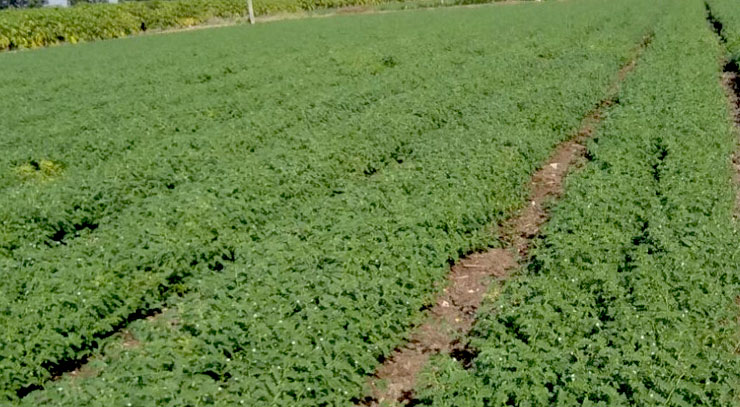
Blog at Jains - Adoption Of Precision Farming Technology Is The Only Way Out For Reducing GHGs Emission And Climate Change In Agriculture
Causes for Climate change
Global WARMING is the slow increase in average temperature of the Earth atmosphere. The increased amounts of energy striking the Earth from the Sun is being trapped in the Earth atmosphere (do not get radiated back to Space) as a result of GHG’s (Green house Gases) present in ever increasing amounts in the atmosphere. The main GHG s are CO2., Methane gas, N2O, Choloro- fluorocarbons (CFC), Hydro fluorocarbons (HFC), Hydrochloro flurocarbons (HCFC), and Sulphur Hexa fluoride (SF6). GWP (Global warming Potential) of these GHGs are measured in reference to CO2. GWP is a measure of how much Energy the emission of 1 ton of a Gas would absorb over a period of time relative to the emission of 1 ton CO2. Larger the GWP, the more a given gas warms the earth compared to CO2 for that time period.
CO2 has a GWP of 1 and it remains in the system for thousands of years.CO2 is emitted when anything is burned; coal , petroleum , biomass.55% of all GHGs is CO2.
Methane gas has a GWP estimated 28-36 times. Though Methane emitted once will last for only 10 years, it absorbs (traps) much more energy than CO2.Methane Gas is Emitted by Combustion process and by Anaerobic Decomposition of organic material
(in paddy fields, Pig and Cow stomachs). Puddled and flooded Paddy cultivation is a major source of Methane gas.
N2O has a very high GWP (265 to 298 times that of CO2.) and the emission will remain
in the earth atmosphere more than 100 years. N2O is emitted mainly by the chemical fertilizers during their production and when they are applied to the soil.
CFC, HFC etc. were created by humans as refrigerants. These gases have GWP range of 1800-8000 and also are very long lasting.
Black carbon (10 micron) particles comes from incomplete burning of fossil fuels. The atmosphere carries them to glaciers and begin melt the ice. (Causing ocean level to rise).BC is second to CO2 as a GW agent.
Human activities causing global warming
Fossil fuels, coal and petroleum are the most important sources of GHGs and black carbon Activities like power generation, industry, transportation, buildings etc. generate GHGs.
Agriculture is the second most important GHG generating human intervention. The following activities generates high volumes of GHGs.
- Flooded paddy cultivation among other irrigated crop farming activities.
- Animal keeping; ruminants like cows and pigs generate methane as a belch during digestion of their feed.
- Feed production itself
- Chemical- intensive crop production,
- Deforestation driven to expand cultivated areas or infrastructure and urbanization.
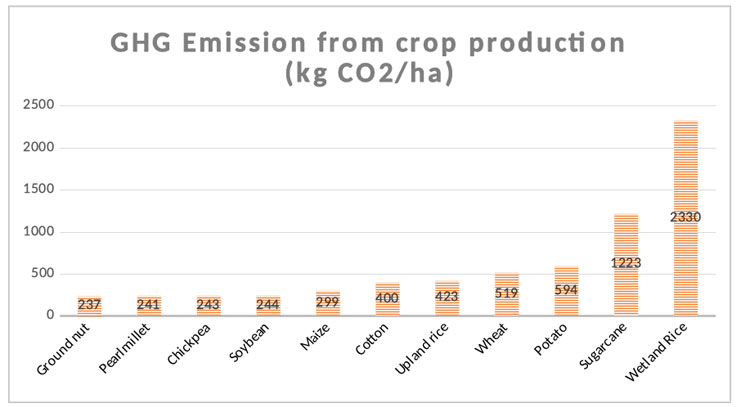
Fig 1. CO2 emission from crop cultivation
How conventional agriculture results in high GHG generation?
Inefficient use and imprecise dosage of inputs- fertilizers, irrigation water and pesticides causes GHG formation in Agriculture.
Events of excess irrigation causes land degradation and salination making further crop production impossible. Excess water in the top soil bring in anaerobic digestion of organic matter by microbes and generation of high volumes of green (GHG) like Methane or Nitrous oxide.
Conventional application of Urea fertilizer in one or two splits results in high mineral load on the land and generates 1. High doses of Nitrous oxide (N2O). 2. Partial production of Ammonia from excess urea leading to climate change. 3. Excess urea generates excess nitrate (NO2) that will move to water channels, streams and wells causing pollution and ends up in the human food chain. As fertilizer additions increase, N2O emissions appear to remain quite static across a broad range of rates (roughly between 90 and 150 kg N ha-1), maybe near the crop demand levels. At higher N rates, emissions tend to increase nonlinearly.
When Phosphorus fertilizer or organic manure (both containing soluble phosphorus) is added in large quantities the build-up of phosphorus in soil occurs. Excess soil phosphorus reduces the ability of plants to take up micro nutrients like Zn and Fe.
The effect of excess Potassium in the soil, however is less impacting the climate compared to those by Nitrogen and Phosphorus fertilizers.
How does Climate change affect crop production?
Changes in the onset, depth and duration of monsoon rains affect growth and development pattern of several crops- impacting flowering time, flower survival, fruit growth, and overall crop calendar and production.
High intensity rain fall events flood or water log fields and destroy crop, causes fruit drop. High intensity rain fall causes landslides and top soil loss in many place resulting in total crop loss.
Higher wind speed damages crops like Banana.
Prolonged drought incidences reduces crop survival and yield. Unusually high temperatures during grain fill in cereals cause low filling rate resulting in more chaff.
Reduction in chilling and non-coincidence of chilling time with crop stage results in poor or low flowering in temperate fruit trees.
Unusually lower temperature for longer duration causes long frost periods that kill crops. Increase in temperature during Anthesis of many crops result in low pollen viability that lead to lower fruiting. One degree rise in temperature reduces wheat production by 4-5 million ton and rice production declines by 10% (IARI, The Earth Institute, 2010).
Increase in temperature due to global warming also result in the alteration in the distribution and intensity of insect and disease pests.
Can carbon sequestration by photosynthesis fully remove the CO2 emission to the atmosphere?
Not fully; and in fact not much effective in removal. 25% CO2 emission produced by human activity is absorbed by plants. A similar amount ends up in Ocean. But 50% of CO2 taken by photosynthesis goes back to atmosphere through respiration. 90% of the rest also returns to atmosphere through microbial activities in the soil and other disturbances like fire.
A tree can absorb up to 21.8 kg CO2 per year by the time it reaches 40 year. Teak has the highest rate of Sequestration of CO2. Among crops, Sugarcane is one of the highest CO2 Sequester- 0.66 ton /ha/yr.
Precision farming (PF)
PF is a management strategy which identifies, analyses and manages within-field variability for increased Productivity and reduced Environmental impact. Site specific management, Prescription farming and Precise Input management are the major drivers of PF. Open field PF is more efficient in terms of retarding Climate change by reducing the GHG emission.
In Developed Countries PF implementation is at a higher level than in developing countries because of application of technologies like;
- GIS and Sub cubic cm soil grid level studies
- Maintenance of uniform Nature of Soil by Sensor based diagnostics and application of inputs
- Adoption of Single Crop Cycle system
- And highly mechanized Farming system where variation due to human intervention is kept to the minimum. In countries like India,
- Prohibitive GIS Cost,
- Diverse nature of the Soil
- Multi -cropping system
- And Manual Farming system (low mechanization)
Makes PF adoption more difficult. But still there are very successful cases where PF is practiced and productivity enhancement is noticed along with reduction in GHG emission.
The following interventions are done for PF adoption in India and the results are found to be excellent.
- Soil Preparation: Humus level, microbial load, aeration & drainage, fertility restoration, mulching.
- Land preparation: Ensure chemical and physical uniformity of top soil
- Nursery: Physically, physiologically uniform seedlings with intact roots
- Crop geometry : Single ,double ,triple and tetra rows (straight and alternate)
- Drip-Fertigation : Water and Nutrients matching with the physiological demand
- Growth management : Regulation of flowering, training the canopy, frost protection.
- Plant protection : Monitoring System , IPM
- Protected cultivation : Adopt Green house, Shade house and Low tunnels
- Field Level PHM : Harvest , handling, sorting, grading and labeling
- Cluster Approach : Registered Precision Farmer’s Associations at Cluster level
- Market linkage : Collective marketing, Market information through IT.
- Empowerment : Cluster Farmers’ Co-operative or Company
Optimum and timely inputs are applied and Higher yields and incomes achieved. The precision interventions/management steps are in the following factors.
- Improved Seeds
- Soil and seed bed management
- Space management (GEOMETRY)
- Sunlight
- Water
- Fertilizer
- Pests
- Mechanization of operations
- Harvest and Post-harvest
Practicing PF
Monitor the soil and plant physicochemical parameters: by analysis and placing sensors (electrical conductivity, nitrates, temperature, evapotranspiration, radiation, leaf and soil moisture, etc.)and the optimal conditions for plant growth can be achieved.
Obtain data in real time: the application of sensing devices in the fields will allow a continuous monitoring of the chosen parameters and will offer real time data ensuring an updated status of the field and plant parameters at all time. Provide better information for management decisions.
Adopt micro irrigation and fertigation with scientifically prepared schedules of water and fertilizer application to manage inputs-irrigation water and fertilizers most precisely in quantity and time. This would save time and costs; reduce fertilizer and chemical application costs, reduce pollution through lesser use of chemicals and lower doses of application.
Provide better farm records essential for sale and succession and monitor the history of agricultural land. These can be integrated with any farm management software, to make all activities on-farm easier and to improve farm productivity. This precision will also reduce the GHG emission.
Objective of PF is to achieve two contrasting goals- to increase crop productivity and to reduce the potential environmental risk by optimizing inputs.
For example , see the figure below. When irrigation volume applied was equivalent to the Evapotranspiration of Potato crop, the yields recorded were the highest. The commonly held erroneous belief that more water more yield is proved wrong. Precision irrigation results in highest yield.
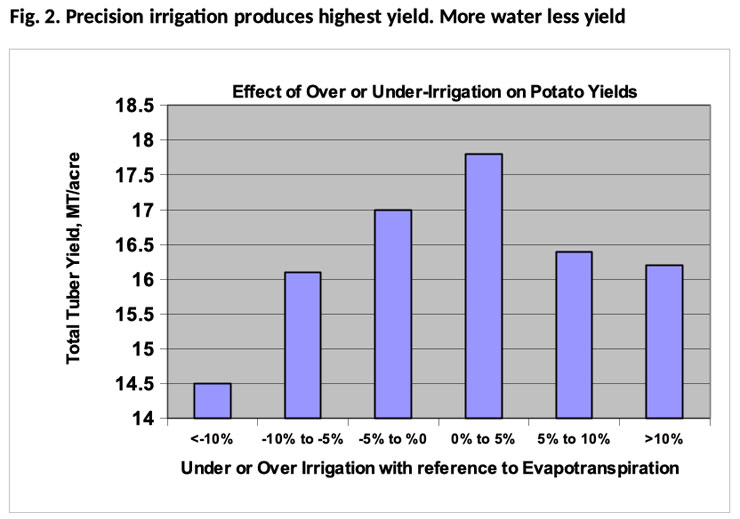
Precision farming technologies, like implementing an irrigation schedule based on crop evapo-transpiration and fertigation schedule where nutrient application rate and time matches the crops’ physiological need for nutrients, type and rate.
How Much water do I need for Rice crop?
Because paddy is the most unscientifically irrigated crop in terms irrigation volumes and paddy is the highest GHG emitting crop, let us study the actual crop water requirement (= ETP) of paddy crop in various locations of differing Evaporative demands and different planting seasons
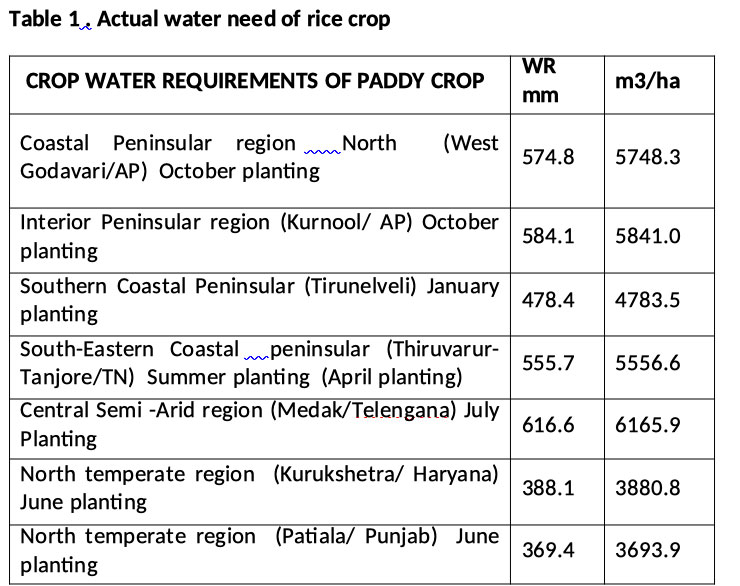
In conventional irrigation of Paddy crop the whole season consumes an average of 23750 m3 in the above regions and the average productivity recorded ranged from 2.0- 2.5 t/ha in farmers field.
Excess irrigation results in high Methane emission (GHG). A change to PF would reduce the GHG load into the atmosphere (see Table 2).
Because of the above strict regimen soil is never loaded with excess fertilizer. This alone is adding to lower rate of residual accumulation in the soil and ground water.
The use of frequent fertigation, combined with improved irrigation scheduling, results in improved fertilizer uptake efficiency, and enhanced water use efficiency, increased residence time of nutrients in the root zone, and reduced potential for groundwater pollution.
In drip –fertigation, water, fertilizer placement, and application frequency are managed more efficiently compared with a dry fertilization program. Productivity gains with irrigation and fertigation, using the same fertilizer doses, increased nutrient use efficiency 25%, compared with flood irrigation and solid fertilizer direct to the soil. For this reason, it is recommended to reduce N and K doses by 20-25% when nutrients are applied through fertigation in relation to the nutrient levels recommended for direct solid fertilizer application to the soil.
Simply by need based (Crop need assessment) fertilizer application through fertigation where very low concentrations (rates) of the fertilizers are applied to the rhizosphere in large number of doses during the crop growing duration. Fertigation schedules prepared by agronomists provides this opportunity. The result is high nutrient use efficiencies and no or nil effect nutrient on the environment. This practice helps in retarding the rapidity of climate change.
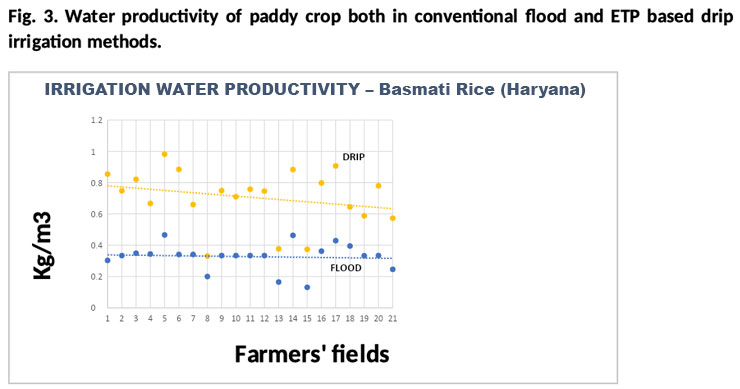
Average Water Productivity under ETP based drip irrigation was around 0.75 kg/m3 while it was 0.36 kg/m3 under conventional flood system. PF method of growing paddy not only reduces water consumption but improves yield also. The GHG emission is reduced by 60 plus %.

The reduced GHG emission resulted from avoidance of high volume flood irrigation and practice of fertigation, both critical input management methods in PF.
Fertigation method of application f chemical fertilizers offers very high FUE (fertilizer use efficiency and a very high percent reduction in GHG due to extra loading of soil by chemical fertilizer, as it happens in direct application of RDF at one or two split doses. Fertigation is an essential step in PF.
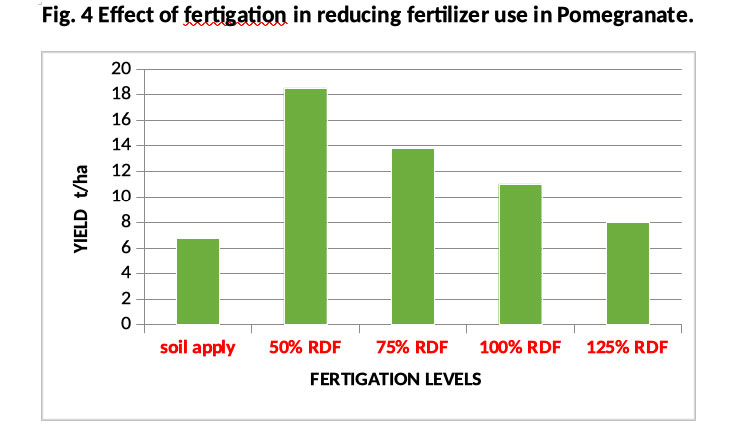
100% recommended dose (RDF) applied to the soil is compared with fertigation at 50% RDF, 75% RDF, and 100 and 125 % RDF. Fertigation at 50% RDF resulted in highest productivity (18 t/ha) making a direct saving of 50% fertilizers. Avoiding direct soil application of solid fertilizers in large quantities reduces GHG emission.
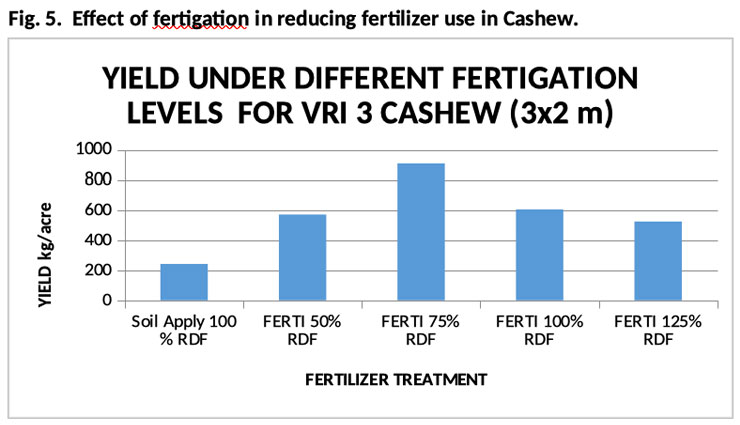
100% recommended dose (RDF) applied to the soil is compared with fertigation at 50% RDF, 75% RDF, and 100 and 125 % RDF. Fertigation at 75% RDF resulted in highest productivity (950 kg/acre) making a direct saving of 25 % fertilizers. Avoiding direct soil application of solid fertilizers in large quantities reduces GHG emission.
Studies like the above with a number of crops show that the recommended fertilizer doses of these crops always result in over-fertilization leading to GHG formation and lower yields. Fertigation enhances FUE (fertilizer Use efficiency) and reduces GHG load on to the atmosphere.
Additionally, practice of IPM methods for pest management also help in PF by reducing chemical load into the environment. Use of insect traps, surveillance and application of chemical control measures only afire arriving at Economic Threshold levels (ETL) improves Crop production and reduces its negative impact on climate change.

